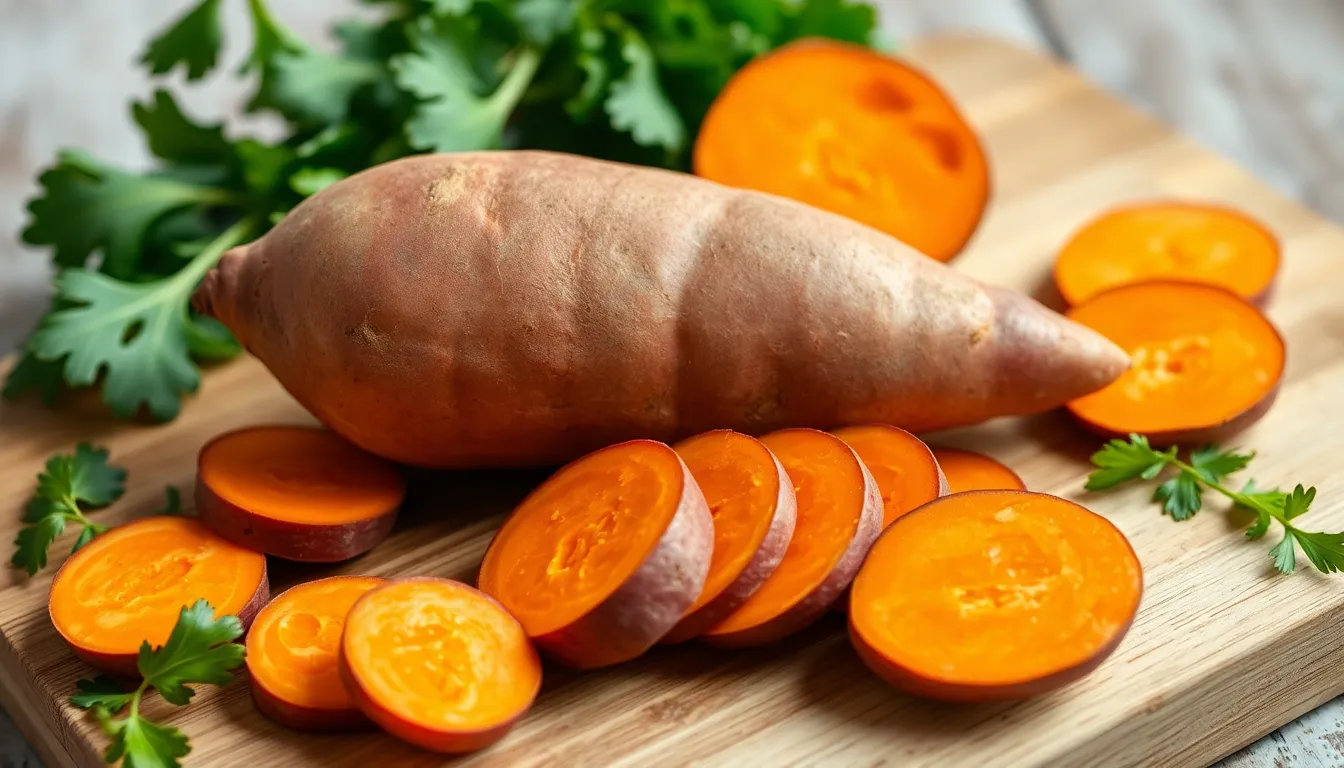Sweet potatoes are a beloved staple in many kitchens, but can they be enjoyed raw? Picture this: you’re munching on a crunchy, vibrant orange snack, and it’s not a carrot. While most people roast or mash these tubers, the idea of eating them raw might seem as wild as wearing socks with sandals. But hold on!
Table of Contents
ToggleCan You Eat Raw Sweet Potato?
Eating raw sweet potato is a topic that raises questions about safety and nutrition. It’s generally safe to consume raw sweet potatoes, but some factors need consideration. Raw sweet potatoes contain specific compounds, like solanine and oxalic acid, which might cause discomfort for some individuals when consumed in large quantities.
Taste and texture vary significantly compared to cooked versions. Raw sweet potatoes offer crunchiness and a slightly nutty flavor, making them a fresh addition to salads or slaws. Nutrient content remains intact in raw sweet potatoes, providing a good source of vitamins A and C. Antioxidants, such as beta-carotene, also remain present in their raw state.
Preparation plays a crucial role in enhancing palatability. Washing and peeling raw sweet potatoes can help reduce any potentially unpleasant taste. Cutting them into thin slices or julienne can improve enjoyment and encourage experimentation in meals.
Raw sweet potatoes are not commonly consumed due to their hard texture and earthy flavor. If someone’s not used to raw starches, they might experience mild digestive issues. Cooking sweet potatoes breaks down cellulose and starches, making nutrients more accessible and flavors richer.
These insights highlight that while eating raw sweet potatoes is possible, cooking them offers distinct flavor profiles and easier digestion.
Nutritional Benefits of Sweet Potatoes

Sweet potatoes offer substantial nutritional advantages that make them a valuable addition to any diet. Their rich nutrient profile supports overall health.
Vitamins and Minerals
Rich in vitamins, sweet potatoes contain high levels of vitamin A, which promotes eye health. They also provide significant amounts of vitamin C, essential for immune function and skin health. Potassium contributes to heart health and helps regulate blood pressure. Iron plays a crucial role in oxygen transport throughout the body. Magnesium supports muscle function and energy production. With each of these vitamins and minerals, raw sweet potatoes deliver essential nutrients while retaining their natural properties.
Dietary Fiber
Dietary fiber in sweet potatoes supports digestive health significantly. Each serving contains about 4 grams of fiber, aiding in regular bowel movements and maintaining gut health. Soluble fiber promotes a feeling of fullness, which can assist with weight management. Additionally, fiber helps regulate blood sugar levels, minimizing spikes after meals. Including raw sweet potatoes in salads or slaws boosts daily fiber intake, which plays an essential role in overall well-being. Consuming fiber-rich foods like sweet potatoes can lead to a balanced diet.
Potential Risks of Eating Raw Sweet Potato
Eating raw sweet potatoes poses certain risks that consumers should consider. Awareness of these factors ensures a safe culinary experience.
Antinutrients in Sweet Potatoes
Sweet potatoes contain antinutrients such as solanine and oxalic acid. These compounds might inhibit nutrient absorption and cause potential health issues. High quantities may lead to gastrointestinal discomfort, making moderation important. Cooking sweet potatoes significantly reduces these antinutrients, enhancing safety and nutrient availability.
Digestive Issues
Consuming raw sweet potatoes can lead to digestive issues for some individuals. The high fiber content can result in bloating or gas, particularly for those with sensitive digestive systems. Raw varieties also possess a tough texture that may challenge digestion. Cooking breaks down fibers, making sweet potatoes easier on the stomach and more palatable. Prioritizing preparation methods can mitigate these potential digestive concerns.
Best Ways to Prepare Sweet Potatoes
Sweet potatoes offer versatile preparation options that enhance their flavor and nutritional value. Choosing the right cooking method elevates their taste and texture.
Cooking Methods
Roasting sweet potatoes creates a caramelized exterior and soft interior. This technique retains moisture while enhancing natural sweetness. Boiling them provides a quicker option, but it may lead to some nutrient loss. Steaming preserves more nutrients, keeping the sweet potatoes vibrant and flavorful. Mashing provides a creamy consistency, making it a comforting side dish. Baking in foil allows for even cooking while keeping them moist. Each method contributes unique flavors and textures, making sweet potatoes a fantastic choice for a variety of dishes.
Nutritional Retention
Cooking sweet potatoes optimizes nutrient retention without compromising their health benefits. Baking and steaming maintain higher levels of vitamins A and C compared to boiling. Roasting enhances antioxidant content, which supports overall health. Nutrients remain accessible when cooked, ensuring the body absorbs them efficiently. Consuming cooked sweet potatoes supplies fiber while reducing antinutrient levels, promoting digestive health. Preparation methods that utilize lower temperatures, like steaming, maximize vitamin preservation. Prioritizing specific cooking techniques ensures sweet potatoes deliver optimal nutrition.
Raw sweet potatoes can be a unique addition to one’s diet but come with considerations. While they’re safe to eat and packed with nutrients, the tough texture and potential digestive issues may deter many from enjoying them in their raw form. Cooking sweet potatoes not only enhances their flavor but also improves digestibility and nutrient absorption. For those looking to diversify their meals, incorporating raw sweet potatoes in moderation can provide crunchy texture and added fiber. Ultimately, the choice between raw and cooked sweet potatoes depends on personal preference and digestive tolerance.

